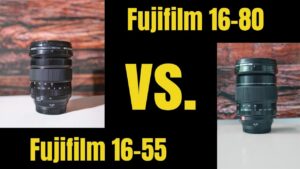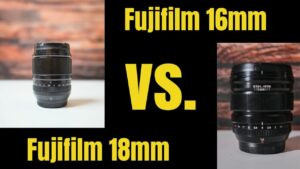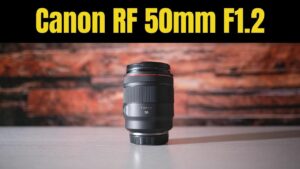Quick Facts about the Fujifilm XF 8-16mm F2.8 R LM WR Lens
- Weight: 1.77 lb/805 Grams
- Weather Sealed: Yes
- Filter Size: N/A Bulbous Front 🙁
- Angle of View: 121 Degrees to 83.2 Degrees
- Focusing Distance: 9.84″/.25m
- Max Aperture: F2.8
- Minimum Aperture: F22
- Image Stabilization: No 🙁
- Mount System: Fuji X
- Price: $1,999
- Zoom: Internal
*LM=Linear Motor
Quick Facts about the Fujifilm XF 10-24mm F4 R OIS WR Lens
- Weight: 13.6 oz/385 Grams
- Weather Sealed: Yes (There is a previous version that is not. However, it has the same optical formula.)
- Filter Size: 72mm
- Angle of View: 110 to 61.2 Degrees
- Focusing Distance: 9.4″/ 24 cm
- Max Aperture: F4
- Minimum Aperture: F22
- Image Stabilization: Yes
- Mount System: Fuji X
- Price: $999
- Zoom: Internal
*OIS= Optical Image Stabilization
*WR= Weather Resistant

Why compare the Fujifilm 10-24 vs the 8-16mm?/Who are both of these lenses for?
To put it simply, when examining the Fujifilm XF system, there are only two wide-angle zoom lenses, the 8-16mm F2.8 and this 10-24mm.
Now, of course there are some other reasons to compare, such as:
- Is the 8-16 actually worth the extra $1,000?
- How do I protect the front lens element of the 8-16mm, as it has a bulbous front?
- Given that the 8-16mm is a red-badge, how does sharpness compare against the 10-24?
- Is the added benefit of OIS on the 10-24 worth the cost?
- And so much more.
The 8-16mm is also unique, as it has a FOV of over 120 degrees. For my style of photography, that is amazing but totally unnecessary.
From my initial impressions, the 8-16mm F2.8 is built only for those that are 100% certain that they need it. Otherwise, the 10-24 will do for most.
But let’s go ahead and check the sharpness, build quality, and other things to truly see of that’s the case.
What other wide-angle lenses exist within the Fuji-X lineup?
Zoom Lenses
There are no other XF wide-angle XF zoom lenses besides the 8-16mm and the 10-24mm.
- Fujifilm 14mm F2.8
An optical masterpiece that can focus on objects extremely close (5.91 inches), the Fujifilm 16mm F1.4 is in a league of its own. (But if you are starting to go this field of view, you might look at the new 18mm F1.4 WR, too.)
- Fujifilm 16mm F2.8
A compact version of the 16mm F1.4, the 16mm F2.8 is a perfect companion for those looking for superior image quality in a small body. The perfect pairing would either be the X-E or XTXX Line.
- Samyang/Rokinon 12mm F2 (AF & MF)
Probably one of the best XF lenses for night-sky photography, the Samyang/Rokinon lens has recently had a refresh with autofocus. I’ve heard mixed reviews about the autofocus lens, but the manual focus lens can still be found for sub-$200.
- Viltrox 13mm F1.4
Dials, Switches, Buttons, Tripod foot, and More
There are no dials, switches, or buttons on the newer 10-24mm F4 WR or the 8-16mm.
I suppose that the only “extra” feature is that both lenses are weather-resistant.
Although, if you can find the original 10-24, it did have both an OIS and auto-aperture switch.
Build Quality Comparison
Looking and feeling the lenses, it appears that both lenses are made of the same material, metal with rubberized zoom rings.
However, the weight difference is substantial.
Because of the 2.8 aperture, the 8-16mm F2.8 weighs 1.8lbs / 805 grams. Meanwhile, the 10-24mm F4 weighs 13.6 ounces / 385 grams.
| 8-16mm F2.8 Dimensions (Diameter x Length) | 88mm x 121.5 mm |
| 10-24 F4 Dimensions (Diameter x Length) | 77mm x 87 mm |
Now, I have two grips with the build quality of the 8-16mm F2.8, and they aren’t due to the materials themselves, actually. (The 8-16 feels like a rock, literally.)
- Lens Hood
I just really found the 8-16mm 2.8’s lens hood just weird compared to the 10-24mm. I think it would be harder to replace overseas.
- Manual Focus and Zoom Focus Rings
How far is the FOV?
- Angle of View: 110 to 61.2 Degrees
- Angle of View: 121 Degrees to 83.2 Degrees
- Angle of view for Human Eye: About 46 Degrees
8-16 vs 10-24 Sharpness Test
- I did not compare the 8-16mm F2.8 at any focal length with an aperture of F2.8. I did not think it was fair to compare the two. (I.e. compare 10-24mm @F4 with 10mm @F2.8)
8-16mm At 8mm
Center
- From F2.8 to F11, the image quality is good
- But the peak sharpness starts about F4-F5.6
- F4 – F11 perform about the same
- Noticeable drop in image quality at F11 and F16
Corner
- 8mm at F2.8 is mediocre at best
- We started to see some improvement at F4
- F5.6 is alright, but true peak sharpness is not until F8 and it goes through F11
- F11 reveals some loss in image quality, but it becomes noticeable in F16
- @F4
- The 8-16mm F2.8 is sharper in both the corner and center of the frame.
- @F5.6
- By the time you arrive at F5.6, the 8-16mm and 10-24mm perform about the same.
- @F8
- The 8-16mm F2.8 and the 10-24 are at similar levels of sharpness at 10mm @F8.
- @F11
- At F11, the center sharpness of the lenses still perform about the same.
- However, the corners of the 8-16mm perform just a little bit better than the 10-24mm.
- @F4
- The center sharpness of both lenses is similar. However, the 8-16mm has a microscopic level of detail that is above the 10-24 in the corners. To most, this will not be noticeable.
- @F5.6
- Same performance in both center and corners.
- @F8
- Again, same performance in both corner and center.
- @F11
- I hate to say the same thing again. But similar performance in both the center and corners.
- @F4
- The 8-16mm might be slightly sharper in the center. The corners follow suit. However, I think 9/10 people will not notice.
- @F5.6
- Similar levels of sharpness
- @F8
- Similar levels of sharpness
- @F11
- Similar Levels of Sharpness
Bokeh Test
The Fujifilm 10-24 and 8-16mm are certainly not going to be producing the jaw-dropping bokeh of the 90mm F2. Additionally, we just are not going to get great bokeh at these focal lengths. 8mm at F2.8 certainly looks jarring, and more like a shaky photo than actual bokeh. So, the 10-24mm wins because you can shoot at 24mm at F4. Simple as that.
Bokeh Balls Test
8-16mm F2.8
- F2.8
- F3.2
The corners are kind-of starting to round out, but it took me some time to decide if this was any noticeable improvement.
- F4 and Beyond
By now, the bokeh balls are round. But it’s going to be difficult to get bokeh balls at this aperture.
10-24mm F4
Now, I recognize that with the 10-24mm, we are starting with an aperture of F4 instead of F2.8. However, I was pleasantly surprised that the bokeh balls are already round starting at F4.
This is an interesting phenomena, as the 10-24mm actually only has 7 rounded diaphragm blades. Meanwhile, the 8-16mm actually has 9 rounded diaphragm blades.
In Conclusion
Realistically, this test is not going to matter too much for 95% of photographers. Most people do not use wide-angle lenses with the intent on using the bokeh balls. Typically, those are reserved for portrait lenses.
Autofocus Test
Both lenses are quick to focus, and I did not see much of a difference in both responsiveness or tracking while in autofocus.
SOOC: Fujifilm X-T4
4k60 w/1.18x Crop
Eye Autofocus
Face Detection-ON/Eye-AUTO
Tracking Sensitivity +2 AF/Speed +3
Focusing Distance and Macro Test
Not going to be confused for a macro lens. The 8-16mm has a minimum focusing distance of 9.84″/25cm. Meanwhile, the 10-24 actually comes in closer with a focusing distance of 9.4″/24cm from the sensor plane.
The max magnification of the 8-16mm is .1x, and the 10-24 is .16x.
OIS/IBIS vs. Just OIS: Fujifilm’s Corner Woble Fuji
Wide-angle lenses don’t magnify camera shake as much as telephoto lenses do, which is why it is actually easier to get “sharp” photographs with this lenses. (Dependent on Shutter speed of course.)
However, within the XF system, there is also something else at play, optical image stabilization and internal body image stabilization.
OIS is built within the camera lens, and you can find IBIS within the camera body. Sometimes, these systems are great. However, sometimes the mechanics and OIS of the lens actually work against the IBIS of the camera body (pitch, yaw, and roll.)
The best systems work with each other. However, if you introduce a 4th variable, an extremely wide FOV, it sometimes can result in shaky corners.
I have found that the 10-24 handles this well for the most part, but I introduced a crop into the scenario as I shoot in 4k60.
Now, two more things. You can also introduce another crop with digital stabilization in-body. But the X-T4 and X-H2 don’t handle this very well.
Instead, I recommend using the warp stabilization in your post-production software. As you can see from this video, it does a much better job. With a FOV this wide, you might have a lot of extra stuff that you can crop from the corners, anyway.
Starburst/Sunburst
The 8-16mm’s sunstars are certainly not as good as the 10-24mm, in my opinion. The 10-24mm’s starburst affect also appears sooner in the aperture range, too.
Intro to Focus Limiters on the X-Series
If you are using the autofocus of this system, you will know that it is less than reliable. Additionally, the FOV means that it may actually focus on something or someone behind your subject, rather than the thing taking up the entire frame.
So, you will need to introduce a focus limiter with these wide-angle lenses. (Especially in video.)
A focus limiter will tell the camera where to look for the subject.
Wide-Angle Distortion
Distortion occurs at both the extreme telephoto and wide-angle. This is just a friendly reminder to not actually get too close to your subject with these lenses.

Sample Images
Why should I pick the 8-16mm F2.8 over the 10-24mm?
- The Extreme FOV
- Minor Sharpness Upgrade
Why should I pick the 10-24mm F4 over the 8-16mm F2.8?
- The 10-24’s OIS offsets the F2.8 aperture of the 8-16mm
I think this one is controversial, but you really need to ask yourself if the 10-24 F4 with OIS is more valuable than the 8-16mm F2.8 with no OIS. To me, these offset and you cannot forget the $1,000 difference between the two.
- Circular Filters
The bulbous front means you will be spending a lot more money on filter systems, if you elect to do so. Meanwhile, the 10-24mm has a diameter of only 72mm. This is not just another cost benefit, but also time. It’s much easier to just screw on circular filters than replacing the glass of a filter system.
- Sunstars
How to Save Some Money on the 10-24mm F4
My Final Ratings
Fujifilm XF 8-16mm F2.8 R LM WR
Reliability: 3.5/5
It certainly regains some points here for the superb build construction. But it does lose a lot of points for corner sharpness not being the best and horrible distortion. (Typical of wide-angle lenses.) It also lost .5 point for having mediocre sunstars.
Functionality: 3/5
Look, the FOV of 8-16mm is so niche that most people don’t use it.
Style :5/5
It looks solid and kind-of cool.
Total: 13.5/20 or 67.5%
Fujifilm XF 10-24mm F4 R OIS WR
Price: 4.5/5
If it was $100 cheaper, this lens would be a steal. However, you can find non weather-resistant copies for about $500 used.
Reliability: 4.5/5
I wish I could use this lens at 24mm for photography. However, this might be Fuji’s best wide-angle video lens. The OIS is a great addition, and the weather resistance provides a nice touch.
Functionality: 4/5
Is 10mm (15mm FF) too much? I will let you be the judge.
Something I learned in Europe is most buildings were built to human eye-scale. So, you will never really need anything more than 16mm (24mm), if you are focusing on architecture photography.
Style: 5/5
Well built and a nice coating of black paint. Not a huge fan of the lens-hood petal, but I can make it work.
Total: 18/20 or 90%.

Fujifilm 16-55 vs 16-80mm F4
The Fujifilm 16-80mm F4 and 16-55mm F2.8 are some of the most expensive “normal” zoom lenses that Fuji makes. Is the 16-80 so bad? And is the 16-55 better?

Fujifilm 18mm vs 16mm F1.4
Two of the best performing wide-angle, XF lenses made by Fujifilm, the 18mm and 16mm should be a comparison that most people think about. But why don’t they?

Fujifilm 50mm F1 vs 90mm F2
Quick Facts about the Fujifilm 90mm F2 LM WR Weight: 1.19lbs/540 Grams Weather Sealed: Yes Filter Size: 62mm Angle of View: 17.9 Degrees Focusing Distance:
































































